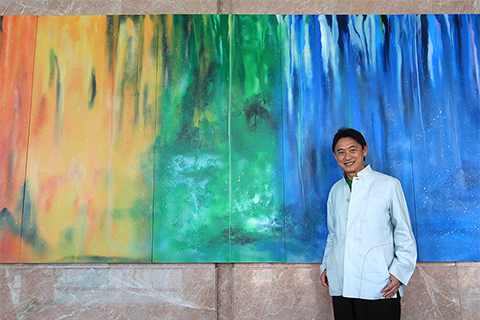Dominic Man-Kit Lam (PhD 1970) is often called a modern Renaissance man. No doubt about that: he has excelled in both science and art, not to mention business and philanthropy. Yet for all his varied achievements, there is a common thread in most of them: the human eye. An expert in ophthalmology, he is the founder and chairman of the Hong Kong-based World Eye Organization, which treats low-income people for eye diseases. His personal wealth originates from a breakthrough in cataract treatment. And he is an internationally respected artist who first made his mark – and created a new art form – by photographing the eye.
From the start, Lam was a Renaissance man in a hurry. After getting his PhD at U of T in a year and a half, he earned a post-doc in ophthalmology from Harvard Medical School and at 24 joined its faculty. He soon moved on to Baylor College of Medicine in Houston, where he came up with the biotech-based means of preventing secondary cataracts that made him financially independent. In Texas, they call him the father of the state’s biotech industry.
But there was always that other half of his brain, demanding equal time. Born in China and raised in Hong Kong, Lam – who is now 65 – had first learned Chinese painting at age 6, and loved it. His parents, however, wanted him to follow a less precarious career path. “If I couldn’t be a visual artist,” says Lam from his office in Hong Kong, “I decided I would be a visual scientist.”
Or both at once. While photographing the eye in 1980, he discovered a new artistic process now known as chromoskedasic painting, which allows colour images to appear vividly on black and white photographic paper without use of dyes or pigments. His artworks, ranging from chromoskedasic to traditional Chinese styles to abstract expressionism, now hang permanently in major halls of government in Beijing as well as top international galleries. One of his pieces sold recently in the U.S. for $1 million. Many of his artworks are very large – in all things, Lam likes to think big. His World Eye Organization, mainly selffunded, is well on the way to its goal of establishing an eye hospital in every province of China by 2020. After that, he would like to expand internationally.
And his most significant accomplishment may be yet to come, based on his 20 years of research into “edible vaccines” – genetically inserting material into fruits and vegetables to prevent disease. Once approved by regulators, the patented process (which Time named one of the 10 most important inventions of the 21st century) would dramatically reduce the cost of delivering vaccines to humans and farm animals. “In 10 to 20 years, nobody will need an injection,” says Lam. “They will just drink tomato juice or eat corn.”
So what is he in his heart – scientist or artist? Or businessman or philanthropist? “I don’t think I can be classified conventionally,” he says. “All of the above.”
Recent Posts
For Greener Buildings, We Need to Rethink How We Construct Them
To meet its pledge to be carbon neutral by 2050, Canada needs to cut emissions from the construction industry. Architecture prof Kelly Doran has ideas
U of T’s 197th Birthday Quiz
Test your knowledge of all things U of T in honour of the university’s 197th anniversary on March 15!
Are Cold Plunges Good for You?
Research suggests they are, in three ways




